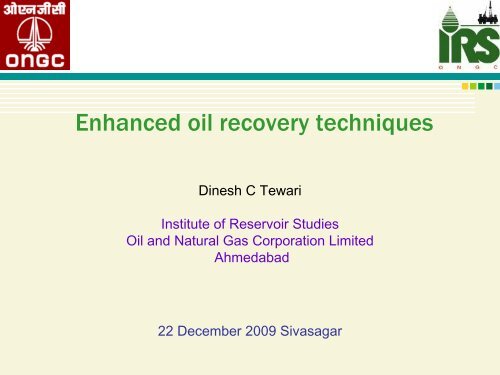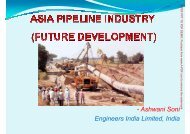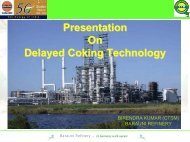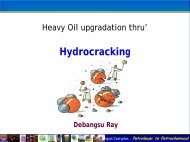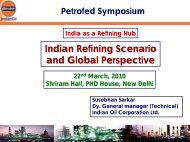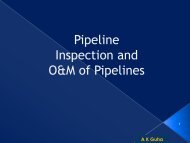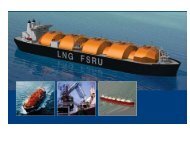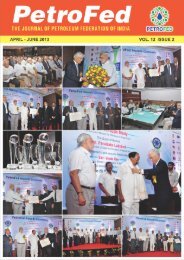Enhanced oil recovery techniques - petrofed.winwinho...
Enhanced oil recovery techniques - petrofed.winwinho...
Enhanced oil recovery techniques - petrofed.winwinho...
Create successful ePaper yourself
Turn your PDF publications into a flip-book with our unique Google optimized e-Paper software.
<strong>Enhanced</strong> <strong>oil</strong> <strong>recovery</strong> <strong>techniques</strong>Dinesh C TewariInstitute of Reservoir StudiesOil and Natural Gas Corporation LimitedAhmedabad22 December 2009 Sivasagar
WHAT COMES TO MIND WHEN THEPRODUCTION OF YOUR WELLSSTART TO DECLINE?What is the purpose of <strong>Enhanced</strong>Oil Recovery?• EOR is intended to improve –– displacement efficiency (at pore level)– sweep efficiency (vertical and areal)• Reduction of residual <strong>oil</strong> saturation isthe key to improving displacementefficiency, which is determined by theCapillary Number
Primary RecoverySecondary RecoveryTertiary RecoveryThermalGasChemical
PRIMARY AND SECONDARY RECOVERYAfter primary and secondary <strong>recovery</strong> (waterflood) <strong>oil</strong>remains in the reservoir as: uncontacted (unswept) <strong>oil</strong> (So = 1 - Swi) partially removed <strong>oil</strong> (1 - Swi < So > Soi) residual <strong>oil</strong> (So = Soi)Secondary and tertiary <strong>recovery</strong> are together referred toas enhanced <strong>oil</strong> <strong>recovery</strong> (EOR).
Incremental IOR/EOR OilIncremental IOR/EOR Oil by means of :IOR Improved Mobility ratioIOR Improved Areal SweepIOR Improved Vertical SweepEOR Lower Residual Oil Saturation
Thermal EOR MethodsTHERMALHot Water Steam In-Situ Elec. HeatCSSSteamFloodSAGDConductiveHeating Forward ReverseHi Press.Air Inj.FracNon-FracVAPEXVAPEX + SteamSAGPDryWetW / AdditivesTHAICAPRI
Thermal EOR ProcessThe principle of thermal EOR is that heat increases the mobility of<strong>oil</strong> by reducing the viscosity.Oil mobility is increased relative to that of water and the mobilityratio is reduced allowing more favourable displacement.
Thermal EOR Process•Steam Flooding Process: In this process, steam iscontinuously introduced into an injection well. When steam isinjected into the reservoir, heat is transferred to the <strong>oil</strong>bearing formation, reservoir fluids and some of the adjacentcap and base rock. The heat reduces the <strong>oil</strong> viscosity. Thisincreases the mobility of <strong>oil</strong>.•As the steam loses heat energy it condenses to yield amixture of steam and hot water. Because of pressure gradienttowards producing well, an <strong>oil</strong> bank is formed ahead of steamzone. This enables the immobile <strong>oil</strong> to get produced from thereservoir. In general steam reduces the <strong>oil</strong> saturation in thesteam zone to very low value (about 10±%. Some <strong>oil</strong> is alsotransported by steam distillation.
Thermal (Steam flooding)
Thermal EOR ProcessTechnical Screening GuidelinesCrude OilGravity : 20cPComposition: Not critical but some light ends for steamdistillation will help.ReservoirType of formation : Sand or sand stone with highporosity and Permeability preferredNet Thickness : >15 feetAverage permeability : >10mDDepth : 300-5000 ftTemperature: Not Critical
Thermal EOR ProcessLimitations :•Oil saturation must be high, and the pay zone should bemore than 15ft thick to minimize the heat losses toadjacent formations.•Lighter, less viscous crude <strong>oil</strong>s can be steam flooded, butnormally they are not if reservoir responds to an ordinarywater flood.•Steam flooding is primarily applicable to viscous <strong>oil</strong> inmassive, high permeability sandstones or unconsolidatedsands.
Thermal EOR ProcessLimitations :•Steam flooded reservoirs should be as shallow as possibleas long as pressure for sufficient injection rates can bemaintained. This is to avoid excessive heat losses in thewell bore.•Steam flooding is not normally used in carbonate reservoir.•Cost per incremental barrel of <strong>oil</strong> is high.•Low percentage of water-sensitive clays is desired forgood injectivity.•Adverse mobility ratio and channeling of steam may makethis process unattractive.
Steam Flooding (Huff and Puff)
Steam Assisted Gravity DrainageHorizontal wells drilled in stacked pairs form the basic unit of SAGDproject (top). Steam injected into the upper well melts surrounding <strong>oil</strong>(bottom). Gravity causes the mobilized <strong>oil</strong> to flow downward to thelower well for production.
Thermal EOR ProcessIn-situ Combustion ProcessThis process involves starting a fire in the reservoir and injectingair to sustain the burning of some of the crude <strong>oil</strong>, usually incombination with water. A combustion front is formed at whichthe injected air burns a small portion of the reservoir <strong>oil</strong>. Theprocess combustion can be achieved through low temperatureoxidation and high temperature oxidation. Low temperatureoxidation is suited for light <strong>oil</strong>. Hot flue gas and steam resultingfrom combustion and water vaporization displace the <strong>oil</strong> aheadof the combustion front. Vaporization of the light ends andthermal cracking also occur. Ahead of the combustion front, thevaporized light ends condense, providing some assistance todisplacement by solvent dilution of the virgin crude.
Thermal EOR Process
Air injectionSCHEMATIC OF SPONTANEOUS IGNITIONSpontaneous IgnitionBridge Plug
TEB port for loading TEBGas InjectionSCHEMATIC OF ARTIFICIAL IGNITIONAir injectionGas BurnerBridge Plug
In-situ Combustion
Thermal EOR ProcessTechnical Screening GuidelinesCrude OilGravity: 15 feetAverage flow capacity : > 20 mD-ftDepth: > 500 ftTemperature: 150oF preferred
LimitationsThermal EOR ProcessThe process will not sustain if sufficient coke is not deposited.Excessive deposition of coke will lead to low advancement ofcombustion front and eventually killing of the process in the presenceof sufficient quantity of air.Oil saturation and porosity must be high to minimize heat loss to rock.Produced flue gases can pose environmental problem.Operation problems such as severe corrosion caused by low pH hotwater, increased sand production, pipe failures as a result of high htemperature and adverse mobility ratio makes this processcomplicated and difficult.Heterogeneous formation can result in poor sweep efficiency.
1008060W/c, %40200Nov-07Nov-06Nov-05ISC Pilot Project : BechrajiNo. of Flowing wells : 121Air Injectors on stream : 4Air Injection Rate, Nm3/d: 100000Cum. Air Injection, NMMm3 : 60Oil rate, tpd : 22Water Cut, % : 55Primary <strong>recovery</strong> : 10%Recovery with EOR : 45%1000800Inititiation of ISC600400Oil RateW/C2000Drive- Active Bottom WaterNov-04Nov-85Nov-86Nov-87Nov-88Nov-89Nov-90Nov-91Nov-92Nov-93Nov-94Nov-95Nov-96Nov-97Nov-98Nov-99Nov-00Nov-01Nov-02Nov-03RF - 10.2 %Viscocity - 300 cpOil rate, tpd
W/c, %Balol FieldBalol FieldIn-situ combustion pilot : March 1990Semi-commercial Phase : Jan. 1992Commercial Phase : Oct. 1997Primary Recovery : ~ 10 %Envisaged additional <strong>recovery</strong> : 36 % :~ 6.57 MMt1000100800Inititiation of ISC80600400W/COil Rate60402000Nov-85Nov-86Nov-87Nov-88Nov-89Nov-90Nov-91Nov-92Nov-93Nov-94Nov-95Nov-96Nov-97Nov-98Nov-99Nov-00Nov-01Nov-02Nov-03Nov-04Nov-05Nov-06Nov-07Oil rate, tpd200Drive- Active Edge WaterRF - 44.8 % ( PR-13%)Viscocity - 150 to 1000 cp
Jun-12Santhal FieldSanthal FieldCommercial Phase : Oct. 1997Primary Recovery : ~17 %Envisaged additional <strong>recovery</strong>: 30 % : 14.57MMtOIL GAIN BY EOR (IN-SITU COMBUSTION) IN SANTHAL FIELD2000Oil Gain by EOR = 1.122 MMt Till Aug '041500START OF ISC10005000EORACTUALENVISAGED PRIMARY RECOVERYJun-74Jun-76Jun-78Jun-80Jun-82Jun-84Jun-86Jun-88Jun-90Jun-92Jun-94Jun-96Jun-98Jun-00Jun-02Jun-04Jun-06Jun-08Jun-10TIME------>Drive- Active Edge WaterRF - 42.8 % ( PR-17%)Viscocity - 50 to 150 cpOIL T/day------->
Non-Thermal EOR MethodsNON-THERMALMiscibleChemicalImm. GasDrivesOtherSlug ProcessPolymerCO 2MEOREnrichedGas DriveSurfactantFlue GasFOAMVaporizingGas DriveAlkalineInert GasCO 2 MiscibleMicellarN2 MiscibleASPAlcoholEmulsion
180160140120100806040200173100Chemical EOR ProcessChemical EOR ProcessAssumed:Primary Rec. 33.3 %OOIPChem. Flood Rec. 33.3 %OIP84 7763 61514026 2412 10 10 9 7 6 4 4 3 3 0.90.6 0.3 0.2Billion BblsS. ArabiaUSAIranIraqKuwaitAbu DhabiVenezuelaRussiaLibyaNigeriaChinaQatarMexicoCanadaBrazilNorwayOmanIndiaUKDubaiDenmarkRomaniaGermanyFrance
Chemical Floods Current Status WorldwideFranceIn d iaIndonesiaVenezuelaUSAChinaTotal Number of Projects: 27
Chemical EOR ProcessOBJECTIVES OF CHEMICAL FLOODING• Increase the Capillary Number Nc to mobilize residual <strong>oil</strong>• Decrease the Mobility Ratio M for better sweep• Emulsification of <strong>oil</strong> to facilitate productionThe process also called as micellar or micro emulsion flooding,consists of injecting a slug that contains surfactant, co-surfactants, <strong>oil</strong>, water and other chemicals. The function of thesurfactant is to reduce <strong>oil</strong>/water interfacial tension, but it mayalso cause inter phase mass transfer of reservoir <strong>oil</strong> and water.Both the inter phase mass transfer and reduction of IFT increase<strong>recovery</strong> of <strong>oil</strong>. Surfactant slug is often followed by polymerthickened water to improve sweep efficiency.
Chemical EOR Process
WATER FLOODInjectorProducer
WATER FLOODInjectorProducer
WATER FLOODInjectorProducer
WATER FLOODInjectorProducer
WATER FLOODInjectorProducer
SURFACTANT FLOODSurfactant follows the waterchannels through the formation
SURFACTANT FLOODInjectorProducer
SURFACTANT FLOODInjectorProducer
SURFACTANT FLOODInjectorProducer
SURFACTANT FLOODInjectorProducer
SURFACTANT FLOODInjectorProducer
SMART SURFACTANT FLOODSmart Surfactant seeks out <strong>oil</strong>bearingchannels, blocks waterchannels
SMART SURFACTANTInjectorProducer
SMART SURFACTANTInjectorProducer
SMART SURFACTANTInjectorProducer
SMART SURFACTANTInjectorProducer
SMART SURFACTANTInjectorProducer
SMART SURFACTANTInjectorProducer
Chemical EOR Process
Chemical EOR ProcessTechnical Screening GuidelinesCrude OilGravity: > 20o APIViscosity : < 100 cPComposition: Light intermediates are desirableReservoirType of formation : Sand stone preferredNet Thickness : > 10ftAverage permeability : > 10mDDepth: 950 to 9000 ft( temperature!)Temperature:
LimitationsChemical EOR Process•Adsorption of chemicals can be detrimental to the process.High temperature leads to degradation of chemicals.•Best results are obtained when alkaline material reacts with crude <strong>oil</strong>.The <strong>oil</strong> should have acid number more than 0.2 mg KOH/g of <strong>oil</strong>.•High amounts of anhydrite, gypsum or clays are undesirable.•Formation water chloride of < 20,000 ppm and divalent ions (Ca++and Mg++)
Chemical EOR ProcessPolymer ProcessThe objective of polymer flooding is to provide betterdisplacement and volumetric sweep efficiencies during awater flood. They do not lower the residual <strong>oil</strong> saturation.They improve <strong>recovery</strong> by increasing the viscosity ofwater, decreasing the mobility of water, contacting a largevolume of the reservoir and reducing the injected fluidmobility to improve aerial and vertical sweep efficiencies.Because, polymer flooding inhibits fingering, the <strong>oil</strong>displacement is more efficient in the early stages ascompared to a conventional water-flood
Chemical EOR Process
Chemical EOR Process
Chemical EOR Process
Chemical EOR Process
Chemical EOR ProcessTechnical Screening GuidelinesCrude OilGravity: > 15o APIViscosity : 10ftAverage permeability : > 10mDDepth: < 9000 ft( temperature!)Temperature: < 229o
Chemical EOR ProcessLimitations and Facts•There are two types polymer synthetically produced polymers(Acrylamidetype) and bio-polymers (Xanthum(gum).•Factors which degrade polymers are salinity, temperature, time,shear rate and presence of divalent ions.•Bio-polymers suffer from bacterial degradation and cause well boreplugging.•Polymers may be ineffective in a mature water flood because of low lmobile <strong>oil</strong> saturation.•High adsorption on reservoir rock may kill the process.•Optimum temperature is a key selection criterion for polymers. Clay Cincrease polymer adsorption.•If <strong>oil</strong> viscosities are high, a higher polymer concentration is needed nto achieve the desired mobility control.•Some heterogeneity is acceptable but for conventional polymerflooding, reservoirs with extensive fractures should be avoided.
Polymer Flood: SanandInjectors :Polymer - 13, Chase Water - 7Injection Rate : 910m3/d (800ppm) , 490m3/d (Water)Envisaged addl. Recovery: ~ 14 %Drive- Active Edge WaterRF - 31.5 %Viscocity - 20 cp
140120100water cut (%)Polymer Flood: SanandPolymer Flood: Sanand806040500450400350300250200150100500200Oil rate (m 3 /d)5/1/19696/1/19707/1/19718/1/19729/1/197310/1/197411/1/197512/1/19761/1/19782/1/19793/1/19804/1/19815/1/19826/1/19837/1/19848/1/19859/1/198610/1/198711/1/198812/1/19891/1/19912/1/19923/1/19934/1/19945/1/19956/1/19967/1/19978/1/19989/1/199910/1/200011/1/200112/31/20021/31/20042/28/20053/31/2006
JhaloraDrive- Active Edge WaterRF - 36.6 %Viscocity - 5-35 cp
Gas Based EOR Process
Gas Based EOR ProcessGas Injection is the second largest enhanced <strong>oil</strong> <strong>recovery</strong>process, next only to thermal processes used in heavy <strong>oil</strong>fields. The residual <strong>oil</strong> saturations in gas swept zones havebeen found to be quite low, however, the volumetric sweepof the flood has always been a cause of concern. Themobility ratio, which controls the volumetric sweep,between the injected gas and displaced <strong>oil</strong> bank in gasprocesses, is typically highly unfavorable due to therelatively low viscosity of the injected phase. This differencemakes mobility and consequently flood profile control thebiggest concerns for the successful application of thisprocess.
Gas Contribution to Green House Effect
Gas Based EOR ProcessMiscible & immiscible gas injection processIn miscible gas injection process mass transfer occur between<strong>oil</strong> & gas & forms a transition zone to displace the <strong>oil</strong> effectively.ely.Miscible gas injection gives better displacement efficiency.Immiscible gas injection improves <strong>recovery</strong> by swelling & <strong>oil</strong>viscosity reduction.Displacement efficiency of immiscible gas injection is less thenmiscible gas injection process.
Gas Based EOR ProcessHydrocarbon Miscible Flooding :Hydrocarbon miscible flooding consists of injecting lighthydrocarbons through the reservoir to form a miscible flood. Theprocess recovers crude <strong>oil</strong> by generating miscibility (in thecondensing and vaporizing gas drive), increasing <strong>oil</strong> volume byswelling and decreasing the viscosity of <strong>oil</strong>. Three different methodsof attaining miscibility are used. One method uses about 5% PV slug sof liquefied petroleum gas such as propane, followed by natural gasor gas and water. A second method called enriched (condensing)gas drive , consists of injecting 10 to 20% PV slug of natural gas gthat is enriched with ethane through hexane(C2 to C6) , followed bylean gas and possible water.
Gas Based EOR ProcessOverall displacement EfficiencyE = Es x Ei x EdWhere Es is areal sweep efficiencyEi is invasion efficiency or vertical sweep efficiencyEd is microscopic displacement efficiency which accounts for thetrapping of <strong>oil</strong> by capillary forces in the pores invaded bydisplacing fluid.
Miscible Gas Flooding(Hydrocarbon Injection)InjectionWellHC GasInjectionfrom Pipelineor RecycleWaterInjectionPumpSeparation andStorage FacilitiesProduction Well4 3 2 11 Oil Zone 2Oil Bank /Miscible Front3HC andWater Zone4 Drive Water
Gas Based EOR ProcessHydrocarbon Miscible Flooding :The enriching components are transferred from gas to the <strong>oil</strong>. Thethird method, called High pressure (Vaporizing) gas drive, consistsstsof injecting lean gas at high pressure to vaporize C2 to C6components from the crude <strong>oil</strong> being displaced. Different types of oHC gas displacement are depicted in the next page.LPG Injection
Gas Based EOR ProcessRich Gas InjectionLean Gas Injection
MISCIBLE GAS PROCESS
Miscible Gas Injection: Gandhar GS-12Waterflood Recovery : 36 %HC Miscible Gas Inj. Recovery: : 57 %Gas Injectors: 10 (4,80000 m3/d)Avg Res Pressure: 270kscOil rate / water cut : 777m3/d / 1%
Gas Based EOR ProcessTechnical Screening GuidelinesCrude OilGravity : > 20o APIViscosity : 10ftAverage permeability : > 5mDDepth: > 700 ft( depending upon miscibility pressure)Temperature: < Not critical
Gas Based EOR ProcessLimitations and Facts•The minimum depth is set by the pressure needed to maintainthe generated miscibility.•A A steeply dipping formation is very desirable to permit somegravity stabilization of the displacement.•Viscous fingering results in poor vertical and horizontal sweepefficiency.•Solvent may be trapped and not recovered.•Injected hydrocarbon gas should be available in sufficientquantity.•Recycling of produced gas may reduce the total gas requirement.
Gas Based EOR ProcessCO2 Flooding (Miscible & Immiscible)This process is carried out by injecting large quantities CO2 (15%or more of the hydrocarbon pore volume) into the reservoir.Miscible displacement by carbon dioxide is similar to vaporizinggas drive. The only difference is a wider range of components; C2 Cto C30 are extracted. As a result, CO2 flood process is applicableleto a wider range of reservoirs at lower miscibility pressure thanthose for the vaporizing gas drive. CO2 is generally soluble incrude <strong>oil</strong>s at reservoir pressures and temperatures. It swells thenet volume of <strong>oil</strong> and reduces its viscosity even before miscibilityityis achieved by vaporizing gas drive mechanism. As miscibility isapproached as a result of multiple contacts both the <strong>oil</strong> phaseand the CO2 phase can flow together because of lower interfacialtension. CO2 can be recycled by extracting it from the crude atthe surface.
Gas Based EOR ProcessCO2 Flooding (Miscible & Immiscible)
Gas Based EOR ProcessAn <strong>oil</strong> of less than 25o API is usually considered unfavorable for fCO2injection.A minimum <strong>oil</strong> saturation of 25-30% is required for this process.A large gas cap is usually an unfavorable factor.If reservoir pressure is considerably below miscibility pressure, , largevolumes of CO2 will be needed to obtain the miscibility.A highly fractured reservoir is usually considered unfavorablebecause the fractures provide a conduit from injection to producingwell.An adequate and reliable source of CO2 at reasonable cost is aprimary requisite.The ratio of vertical to horizontal permeability is critical parameteras it controls the rate at which the CO2 can segregate.Relatively thin permeable zones in the reservoir are technicallyadvantageous because they diminish the tendency of gravityoverride, but the thicker zone have an <strong>oil</strong> volume advantage.
Gas Based EOR ProcessCO2 Flooding (Miscible & Immiscible)Technical Screening GuidelinesCrude OilGravity: > 20o APIViscosity : < 12 cPComposition: High percentages of intermediate hydrocarbons (C5-C20)C20)ReservoirType of formation: Sand stone or carbonate with minimum of fractures, highpermeability streaks preferredNet Thickness : > Relatively thin unless formation is steeply dipping.Average permeability : > 2mD (provided sufficient injection rate can bemaintained)Depth: > Deep enough to allow high enough pressure, pressure required ed forachieving miscibility.Temperature: < Not critical. However pressure requiredincreases with temperature.e.
9 8 1 6 5
Gas Based EOR ProcessCO2 Flooding (Miscible & Immiscible)Limitations•Source of CO2 can act as a Limitation for this process to beapplied.•Very low viscosity of CO2 results in poor mobility control.•Early breakthrough of CO2 causes several problems.•CO2 gets dissolved into formation water making it acidic. Thiscauses corrosion of the tubulars in the well bore.•Repress rising of CO2 for recycling.•A A high requirement of CO2 per incremental barrel of <strong>oil</strong> produced.Safety hazards.
Gas Based EOR ProcessNitrogen Gas Flooding (Miscible and Immiscible)Nitrogen gas flooding <strong>oil</strong> <strong>recovery</strong> method uses the inexpensivenon hydrocarbon gas nitrogen to displace <strong>oil</strong> in system whichmight be miscible or immiscible depending upon the pressureand <strong>oil</strong> composition. Because of their low cost, large volumes ofthese gases may be injected. The process recover <strong>oil</strong> byvaporizing the lighter component of the crude <strong>oil</strong> and generatingmiscibility if the pressure is high enough, providing a gas drivewhere a significant portion of the reservoir volume is filled withlow cost gases. Higher miscibility pressure required compared toall other gases.
Gas Based EOR ProcessNitrogen Gas Flooding (Miscible and Immiscible)Technical Screening GuidelinesCrude OilGravity: > 30o API (miscible), >15o API (Immiscible)Viscosity : < 3 cP (Miscible) , Relatively thin unless formation is steeply dipping.Average permeability : > 5mD (Miscible), >15mD (Immiscible)Depth: > Deep enough to allow high enough pressure, pressurerequired for achieving miscibility.Temperature: < Not critical. However pressure requiredincreases with temperature.e.
Gas Based EOR ProcessNitrogen Gas Flooding (Miscible and Immiscible)Limitations•A good miscibility can be achieved with light <strong>oil</strong>s at high pressureonly. Therefore deep reservoirs are needed.•A steeply dipping reservoir is desired to permit gravitystabilization of the displacement.•Viscous fingering may result in poor vertical and horizontal sweepefficiency.•The non-hydrocarbon gases must be separated from the saleableproduced gases.
Gas Based EOR ProcessWater And Gas injection (WAG):-•Combines improved displacement efficiency of gas flooding withimproved macroscopic sweep by water injection.•Recovery of <strong>oil</strong> by exploiting the segregation of gas to the top andaccumulation of water towards the bottom.
Gas Based EOR ProcessWater And Gas injection (WAG):-The WAG survey conducted by Hadlow reported an ultimate <strong>recovery</strong> ofabout 8–14% 8OOIP, based on simulation and pilot tests. However, the morerecent survey of 2001 by Christensen et al. shows that the averageincrease in <strong>oil</strong> <strong>recovery</strong> was only 5 – 10%. The survey encompassed 59projects. The popularity of the WAG process is evident from the increasingnumber of projects and many successful field wide applications
Gas Based EOR ProcessClassification of WAG Process:-Miscible WAG is same as that of miscible gas injection exceptthat it is altered with water to improve its displacement efficiency.ency.In Miscible gas injection process mass transfer occurs between <strong>oil</strong>and gas and forms a transition zone to displace the <strong>oil</strong> effectively.Immisible gas injection improves <strong>recovery</strong> by swelling and <strong>oil</strong>viscosity reduction. Here gas is immiscible with the <strong>oil</strong>.‘Hybrid-WAG’ process patented by UNOCAL, and the ‘DUWAG’process of Shell. These patented processes namely; Hybrid-WAGand DUWAG were developed to optimize recoveries from gasinjection processes wherein a large slug of CO2 is injected followedowedby 1:1 WAG.
Gas Based EOR ProcessTapering is the decrease in gas-toto-water ratio as the floodprogresses. This is generally done to control the gas mobility and achanneling as well as to prevent early breakthrough of the gas. Thisstep is important especially when the injected gas is expensiveand needs recycling. Tapering is generally done in most of the CO2 Cand hydrocarbon floods and prevailed even in the earliest WAGflood trials.
Gas Based EOR ProcessPerformance of different methods of <strong>oil</strong> <strong>recovery</strong>
Gas Based EOR ProcessPerformance of different methods of <strong>oil</strong> <strong>recovery</strong>
Gas Based EOR ProcessSimultaneous water and gas injection (SWAG):SWAG is similar to WAG except that water and gas injectiontakes place simultaneously. SWAG experiments are performedwith different SWAG (gas-water) ratios. The water and gas areobserved to flow simultaneously in the pores with watercreeping on the pore walls and gas moving in the porecenters. It is observed that residual <strong>oil</strong> ganglia are sandwichedbetween gas-<strong>oil</strong> and water-<strong>oil</strong> menisci from oppositedirections and the <strong>oil</strong> was squeezed out as a result of veryconductive <strong>oil</strong> layers. It is also noted that <strong>recovery</strong> due toSWAG was Independent of the SWAG ratio.
Gas Based EOR Process
Gas Based EOR ProcessDisplacement Efficiency by SWAG in KALOL- IX+XDisplacement Efficiency, %HCPV70.0060.0050.0040.0030.0020.0010.000.000.000 0.500 1.000 1.500 2.000PV Injected, ccDisplacement by Water Flood Displacement by SWAG
Gas Based EOR ProcessSaturation of Oil,Water & Gas During SWAG Injection and Displacement Efficiency%So,Sw,Sg & Displacement Efficiency7060504030201000 0.2 0.4 0.6 0.8 1 1.2 1.4 1.6 1.8 2PV Injected, ccSoswSgDispl.Eff
INCORRECT APPLICATIONS:Miscible Flooding• Of more than 100 floods, only a dozen havebeen commercially successful; failuresbecause of lack of attention to gravitysegregation, and frontal stability• Incompatible <strong>oil</strong> and drive fluid compositionsin multi-contact miscibility• Wrong choice of the drive gas (nitrogen?inert gas?)• Optimistic simulations (poor control ofdiffusivity); unscaled experiments
Microbial EOR process is an in-situ process which is more advantageousthan injection approach. Product formed to aid in <strong>oil</strong> release arebiological organism, they will gone through biodegradationMicrobial EOR Processfulfilling the demand ofenergy it is necessary topetroleum energy sourcereservoir. For this we cando enhanced <strong>oil</strong> <strong>recovery</strong>In present energyscenario overall worldhave need of cheaperenergy source. Forutilize optimumpresent in subsurfaceusing microbes.
Microbial EOR ProcessMicrobial <strong>Enhanced</strong> Oil Recovery (MEOR) relies on microbes to fermenthydrocarbons and produce a by–product that is useful in the <strong>recovery</strong> of<strong>oil</strong>. MEOR functions by channeling <strong>oil</strong> through preferred pathways in thereservoir rock by closing/ plugging off small channels and forcing the <strong>oil</strong> tomigrate through the larger pore spaces. Nutrients such as sugars,phosphates, or nitrates frequently must be injected to stimulate thegrowth of the microbes and aid their performance. The microbes generatesurfactants and carbon dioxide that help to displace the <strong>oil</strong>.Microbial growth can be either within the <strong>oil</strong> reservoir (in situ) or on thesurface where the byproducts from microbes grown in vats are selectivelyremoved from the nutrient media and then injected into the reservoir. Forin situ MEOR processes, the microorganisms must not only survive in thereservoir environment, but must also produce the chemicals necessary for<strong>oil</strong> mobilization.
Microbial EOR ProcessMEOR has two distinct advantages:(1)Microbes do not consume large amountsof energy(2) The use of microbes is not dependenton the price of crude <strong>oil</strong>, as comparedto many of the other EOR processes.In some reservoirs, beneficial microbes are indigenous and only neednutrients to stimulate growth. Because microbial growth occurs atexponential rates, it should be possible to produce large amounts ofuseful products rapidly from inexpensive and/or renewable resources.Thus, MEOR has the potential to be more cost-effective than other EORprocesses. Studies have shown that several microbially-produced biosurfactantscompare very favorably with chemically synthesizedsurfactants. The ability to produce effective surfactants at a low pricemay make it possible to recover substantial amounts of residual <strong>oil</strong>.
THE TECHNIQUE INVOLVES:‣injection of TBHA microbialconsortium along with nutrients inthe reservoir‣incubation of the Consortium.growth and production of usefulmetabolites (acids, biosurfactants.‣Increase mobility of crude <strong>oil</strong>towards wellbore.‣currently applied in huff and puffmode.‣target stripper well/low producer
Microbial EOR Process
MICROBIAL PRODUCTS AND THEIR ACTIONAcidsImproving• porosity• permeabilityGases(CO 2 , CH 4 )• Increase in pore pressure.• Oil swelling• Viscosity reductionSolvents• Dissolving of <strong>oil</strong>Surfactants• Lowering of interfacial tensionPolymers• Mobility control
IDENTIFIED MICROBES FOR MEORPROCESS• Two consortium IRSM-1/IRSM-2 active upto 65°C• S-2 consortium active upto 90°C
Micro Photo Graph of Consortium S-2
Well Selection Criteria forapplication of MEORPARAMETERType of formationDepthRECOMMENDED RANGESand stone (preferably)Less than 8000 ft. (2400 Mts.)Temperature < 90°CPressure, Kg/cm 2 < 300 Kg/cm 2Reservoir rock permeability>50 md°API gravity of crude <strong>oil</strong> > 20Viscosity of <strong>oil</strong> 25 %Salinity as NaCl
Other parameters which areconsidered• Asphaltene, Resins & Wax content of crude• CBL/VDL• Proximity of Fluid Content• GOR• Injectivity• Mode of Lift• Withdrawal rate of well• Rock Mineralogy
Treatment DesignConsists of three steps• Pre-flush• Main Biological solution• After flushInfrastructure facilities required• Four epoxy coated tanks• Blending unit• Pumping unit• Filtration unit
Schematic flow diagram of MEOR JobTANK-1 TANK-2 TANK-3 TANK-450 m 3 50 m 3 50 m 3 50 m 3 FILTERATIONUNITBLENDING UNITWSSPUMPING UNITWSS
100.090.080.070.060.050.040.030.020.010.00.0MEOR PERFORMANCE OF SOB #72 (SS-1B)10.09.08.07.06.05.04.03.02.01.00.0Jun-02Jul-02Aug-02Sep-02Oct-02Nov-02Dec-02Jan-03Feb-03Mar-03Apr-03May-03Jun-03Jul-03Aug-03Sep-03Oct-03Nov-03Dec-03Jan-04Feb-04Mar-04PeriodWater cut % Liquid rate m3/d Oil rate m3/dWater Cut (%)MEOR JOB ON 01.07.02Average Qo & Ql (m3/d)
1009080706050403020100MEOR PERFORMANCE WELL No. SOB # 36 (SS-1B)3530252015105017.01.0419.01.0422.01.0419.06.0421.06.0424.06.0426.06.0428.06.0430.06.0402.07.0404.07.0406.07.0408.07.0410.07.0412.07.0414.07.0416.07.0418.07.07DateWater cut(%)MEOR JOB ON 22-01-04Liquid Rate/Oil Rate (m3/day)Water Cut Liquid Rate Oil RatePRE MEOR JOB
403530Average Qo & Ql (m3/d)1009080706050403020100MEOR PERFORMANCE OF WELL SOB# 100 (SS-1B)25201-Oct-031-Jan-021-Feb-021-Mar-021-Apr-021-May-021-Jun-021-Jul-021-Aug-021-Sep-021-Oct-021-Nov-021-Dec-021-Jan-031-Feb-031-Mar-031-Apr-031-May-031-Jun-031-Jul-031-Sep-031-Aug-03MEOR JOBON 20.06.2002Period151050W/C % Ql (m3/d) Qo (m3/d)Water Cut (%)
1009080706050403020100MEOR PERFORMANCE OF WELL NK # 208 (KS- 1A)353025201510504-Oct-0211-Oct-0231-Oct-0211-Nov-0218-Nov-0225-Nov-022-Dec-029-Dec-0216-Dec-0223-Dec-0230-Dec-026-Jan-0313-Jan-0320-Jan-0327-Jan-034-Feb-0311-Feb-0318-Feb-0325-Feb-034-Mar-0311-Mar-0318-Mar-0325-Mar-0331-Mar-03PeriodW/C % QL (m3/d) qo(m3/d)Water Cut (%)MEOR JOB ON 11.10.2002INCUBATION PERIOD
MEOR JOB PERFORMANCE AT KALOL #104 (XII)201816141230-Apr-0431-Mar-0429-Feb-0431-Jan-0431-Dec-0330-Nov-0331-Oct-0330-Sep-0331-Aug-0331-Jul-0330-Jun-0331-May-0330-Apr-0331-Mar-0328-Feb-0331-Jan-0331-Dec-0230-Nov-0231-Oct-0230-Sep-0231-Aug-0231-Jul-0230-Jun-0231-May-0230-Apr-0231-Mar-0228-Feb-0231-Jan-0231-Dec-0130-Nov-0131-Oct-01100908070605040302010010Mode changed to SRP86420W/C % QL M3/day QO,m3/dDATEWater Cut %Liquid rate / Oil rate m3/d
403530Liquid rate / Oil rate m3/d1002590208015706050104030205100PERFORMANCE OF MEOR JOB IN WELL KALOL#72 (XII)05.06.0230.06.0217.08.0203.09.0218.10.0225.11.0209.02.0320.03.0314.04.0330.06.0331.10.0331.12.0331.01.0417.02.0410.03.0431.03.04PERIODW/C% Ql m3/day Qo0Water Cut %INCUBATION PERIODREPEAT MEOR JOB ON 11.12.2003POST MEOR PERFORMANCEPow er supplychanged toindusrtial feederon 17.02.04PRE MEOR STATUSINCUBATION PERIODMEOR JOB ON 10.06.2002
PERFORMANCE OF MEOR JOB IN KALOL # 56 (IV)20POST MEOR STATUS18Liquid rate, Oil rate m3/d161412MEOR JOBON 15.3.20021031.01.0431.10.0331.05.0309.04.0319.03.0316.02.0329.01.0326.11.0209.11.0211.10.0228.09.0212.09.0227.08.0212.08.0217.07.0218.06.0225.05.0220.04.0215.03.0205.03.021009080706050403020100MODE OF LIFT CHANGEDGL TO SRP ON 05.01.20038INCUBATION PERIOD6420PERIODW/C % Ql- m3/d QoWater Cut %
COST OF MEOR OILMEOR job cost with• Low temp. consortium :- US $ 3 per barrel(IRS M-1 & IRS M-2)• High temp. consortium :- US 3$ to 6$ per barrel(S-2 consortium)Pay out period for• Low temp. consortium :- 2 months• High temp. consortium :- 3 months
Conclusions‣Future <strong>oil</strong> increasingly dependant on IOR/EOR‣Strong cost pressures‣Applications of modern technology (multilaterals,smart wells)‣Efficient reservoir management required‣Look for innovative ways continuing(research)‣Fiscal incentives & environmental pressuresmay steer direction
Conclusions•The forces holding back the <strong>oil</strong> in the porous rock are theinterfacial tension between <strong>oil</strong> and water, and the viscosity ofthe crude <strong>oil</strong>.• EOR has been utilized to overcome or to minimize thephysical and geological effects to mobilize additional <strong>oil</strong>.• It’s usually applied after primary and secondary <strong>recovery</strong>.• There is no universal method to be applied in any reservoir•Certain reservoir and fluid parameters have to be consideredby selecting any EOR methods• Improvement of EOR can be achieved in conjunction withother advanced technologies, such as horizontal drilling etc…


